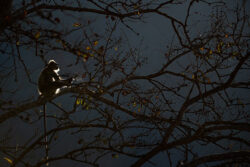There are over 500 species of birds reported from Karnataka. A large number of them are found in the Western Ghats and many are endemic to the region. We had written about the Endemic Birds of the Western Ghats – Part 1 and Part 2 earlier. This feature is the third and final part of this series.
Nilgiri Flowerpeckers are amongst the smallest birds in India (~9 cm long). They are found in hill forests of the Western Ghats and in the edges of forests, plantations and gardens. Seen singly or in pairs, they browse mid to high canopy trees to feed on nectar and insects.

Nilgiri Flowerpecker (Dicaeum concolor)
The Broad-tailed Grassbird has a small, fragmented and declining range in the Western Ghats, where it is known from Maharashtra, Karnataka, Kerala and Tamil Nadu. It inhabits dense, tall grass and reeds, interspersed with patchy scrub and bushes on open hillsides, sometimes on steep slopes, but particularly marshy or damp depressions around hilltops, at 900-2,000 m.

Broad-tailed Grassbird (Schoenicola platyurus)
A recent paper (VV Robin et al) that looked at evidence from genetic, morphometric, song, and plumage data, revealed that two songbird lineages endemic to the Western Ghats montane forest each have diversified into multiple distinct species.
Part 2 of the endemics series covered the erstwhile shortwings which are now called Sholicola (genus), common name Sholakili – ‘shola dweller’.
Three laughingthrush species (with many races) were formerly considered from the Western Ghats. The same paper has separated two of these from laughingthrushes to a family called Montecincla with the suggested common name Chilappan – ‘joyful cacklers’. Of the four distinct species described, two are featured here:

Nilgiri Chilappan or Black-chinned Laughingthrush (Montecincla cachinnans)

Palani Chilappan or Grey-breasted Laughingthrush (Montecincla fairbanki)
The third – Wayanad Laughingthrush – is the only true laughingthrush of the Western Ghats and will remain as is. It is found in low to mid elevations in evergreen forests with bamboo. A noisy, gregarious bird, it is sometimes known to form large flocks.

Wayanad Laughingthrush (Garrulax delesserti)
The Nilgiri Flycatcher’s range is restricted to high-elevation shola forests of the Western Ghats, mainly the Southern and Central part of the Ghats, but is a locally common species. Upright in stance, it sallies after insects from mid-canopy. Males are more brighter than females. The species can be confused with the Verditer Flycatcher which winters in the Western Ghats.

Nilgiri Flycatcher (Eumyias albicaudatus)
The White-bellied Blue Flycatcher is found throughout the low elevations of Western Ghats, typically in the lower canopy level. It is a very robust and slow moving flycatcher, more often heard than seen. The bird usually prefers wet forests and adjoining plantations. It can be found singly or in pairs, and sometimes participates in mixed hunting flocks.

White-bellied Blue Flycatcher (Cyornis pallipes)
The Malabar Woodshrike is a species of woodshrike endemic to the Western Ghats. It was earlier considered a subspecies of the Large Woodshrike. Found in forests, forest edges and plantations, it is usually seen in small flocks and also participates in mixed hunting parties with minivets, drongos, woodpeckers, nuthatches, etc.

Malabar Woodshrike (Tephrodornis sylvicola)
The Dark-fronted Babbler is found in the Western Ghats in wet forests and plantations. An under-storey canopy species usually found in small flocks, it takes part in mixed hunting flocks with other babblers, flycatchers, fulvettas, etc.

Dark-fronted Babbler (Rhopocichla atriceps)





Instagram
junglelodgesjlr